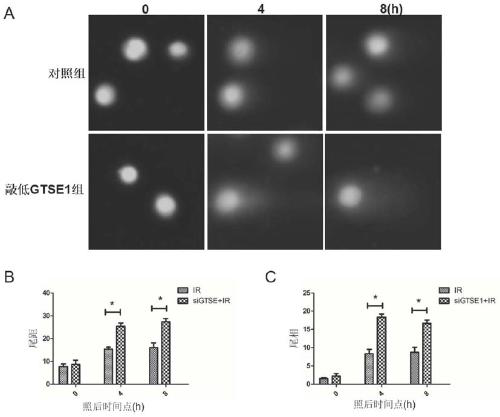Application of reagent for inhibiting or down-regulating expression of GTSE1 gene in preparation of tumor radiotherapy sensitization drug
A technology of gene expression and tumor radiotherapy, applied in the field of biomedicine, can solve the problems of no one reporting and achieve the effect of improving sensitivity, increasing radiation sensitivity, and promoting DNA damage
- Summary
- Abstract
- Description
- Claims
- Application Information
AI Technical Summary
Problems solved by technology
Method used
Image
Examples
Embodiment 1
[0031] Embodiment 1, GTSE1 siRNA transfection
[0032] Transfect GTSE1 siRNA into lung cancer cells A549, H460, and H1299, taking transfection of A549 cells as an example, the cell transfection process is as follows:
[0033] (1) Cell culture: A549 cells were cultured in DMEM medium containing 10% fetal bovine serum; the cells were placed at 37°C, 5% CO 2 Cultured in an incubator, subcultured every 2-3 days, and the cells in the logarithmic growth phase were used for experiments.
[0034] (2) Cell transfection: The day before transfection, the cells were digested with trypsin, counted, inoculated in a 6-well plate at an appropriate density, and placed in CO 2 Cultivate overnight in an incubator, so that the confluence of the cells on the day of transfection is 70%-90%. Avoid antibiotics during plating and transfection.
[0035] Preparation of transfection solution: plasmid: Lipofectamine3000 dosage ratio was 1 μg / well: 1.5 μl / well. Add 500ngDNA and 5μL LP3000 to each well,...
Embodiment 2
[0038] Example 2, GTSE1 siRNA enhances the radiation sensitivity of lung cancer cells
[0039] (1) Cell culture and cell transfection method are the same as embodiment one;
[0040] (2) Cell clone formation method:
[0041] Take lung cancer A549, H460, H1299 cells in the logarithmic growth phase and A549, H460, H1299 cells transfected with GTSE1siRNA for 72 hours, and inoculate different numbers of cells into six-well plates according to different irradiation dose requirements (0,2,4, The number of cells inoculated with 8Gy dose was 200, 400, 800 and 1600, respectively).
[0042] The three groups of cells were irradiated with different doses (0-8Gy) of γ-rays at the same time, and continued to culture after irradiation until obvious cell clones visible to the naked eye appeared in the culture dish, and the culture was terminated. The medium was discarded, washed twice with PBS, fixed with anhydrous methanol for 30 minutes, stained with Gimsa stain for 30 minutes, rinsed with...
Embodiment 3
[0044] Example 3, GTSE1 siRNA promotes apoptosis of lung cancer cells
[0045] (1) Cell culture and cell transfection are the same as in Example 1;
[0046] (2) Cell apoptosis detection by flow cytometry: Take A549, H460, H1299 cells in the logarithmic growth phase and A549, H460, H1299 cells transfected with GTSE1siRNA for 72 hours, respectively, with 1 × 10 5 / mL concentration was inoculated into six-well plates, and each group of cells was given 8Gy 60 Coγ-ray irradiation, and then continue to culture for 24 hours, use EDTA-free trypsin to digest cells, centrifuge at 1500 rpm for 5 minutes, wash with PBS three times, use Annexin V-FITC and PI double staining to detect cell apoptosis by flow cytometry .
[0047] The result is as image 3 As shown, the apoptosis rate of A549, H460, H1299 cells transfected with GTSE1siRNA for 72 hours was significantly higher than that of normal A549, H460, H1299 cell groups.
PUM
 Login to View More
Login to View More Abstract
Description
Claims
Application Information
 Login to View More
Login to View More - R&D
- Intellectual Property
- Life Sciences
- Materials
- Tech Scout
- Unparalleled Data Quality
- Higher Quality Content
- 60% Fewer Hallucinations
Browse by: Latest US Patents, China's latest patents, Technical Efficacy Thesaurus, Application Domain, Technology Topic, Popular Technical Reports.
© 2025 PatSnap. All rights reserved.Legal|Privacy policy|Modern Slavery Act Transparency Statement|Sitemap|About US| Contact US: help@patsnap.com



